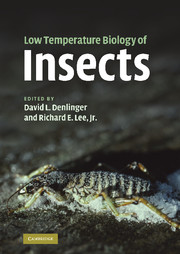Book contents
- Frontmatter
- Contents
- List of contributors
- Preface
- PART I PHYSIOLOGICAL AND MOLECULAR RESPONSES
- 1 A primer on insect cold-tolerance
- 2 Rapid cold-hardening: Ecological significance and underpinning mechanisms
- 3 Antifreeze and ice-nucleator proteins
- 4 Genomics, proteomics and metabolomics: Finding the other players in insect cold-tolerance
- 5 Cell structural modifications in insects at low temperatures
- 6 Oxygen: Stress and adaptation in cold-hardy insects
- 7 Interactions between cold, desiccation and environmental toxins
- PART II ECOLOGICAL AND EVOLUTIONARY RESPONSES
- PART III PRACTICAL APPLICATIONS
- Index
- References
5 - Cell structural modifications in insects at low temperatures
from PART I - PHYSIOLOGICAL AND MOLECULAR RESPONSES
Published online by Cambridge University Press: 04 May 2010
- Frontmatter
- Contents
- List of contributors
- Preface
- PART I PHYSIOLOGICAL AND MOLECULAR RESPONSES
- 1 A primer on insect cold-tolerance
- 2 Rapid cold-hardening: Ecological significance and underpinning mechanisms
- 3 Antifreeze and ice-nucleator proteins
- 4 Genomics, proteomics and metabolomics: Finding the other players in insect cold-tolerance
- 5 Cell structural modifications in insects at low temperatures
- 6 Oxygen: Stress and adaptation in cold-hardy insects
- 7 Interactions between cold, desiccation and environmental toxins
- PART II ECOLOGICAL AND EVOLUTIONARY RESPONSES
- PART III PRACTICAL APPLICATIONS
- Index
- References
Summary
Introduction
Cells of poikilotherm organisms are subjected to a whole range of variation in environmental temperature and have evolved powerful responses to cope with daily and seasonal temperature fluctuations (Lee, 1991). This chapter deals with the acclimatory changes of the basic cell structural components, such as biological membranes, cytoskeleton, organelles (mitochondria) and large (nucleo) protein complexes, which were observed in preparation for, or in a direct response to, a decline in environmental temperature in insects. The main focus will be on biological membranes because this information is by far the most complete, and the situation in insects may be compared to knowledge on fish and other poikilotherms (Cossins and Sinensky, 1984; Cossins, 1994; Hazel, 1989; 1995; Hazel and Williams, 1990).
Considering the adaptive meaning of acclimatory responses, two broad categories can be theoretically distinguished: (i) compensation of physiological function (capacity adaptation) and (ii) preservation of biological structure (resistance adaptation) (Cossins and Bowler, 1987). Some insects inhabiting temperate zones remain fully active in buffered microhabitats throughout the cold season (Aitchison, 1979a, b), and such insects probably need a certain level of physiological compensation. Most species, however, spend winter in dormancy (Koštál et al., 2006), and those insects probably have to rely more on resistance mechanisms. Strong resistance mechanisms can be expected in those insects that undergo freezing or dehydration, sometimes reaching the cryptobiotic state (sensu Clegg, 2001).
- Type
- Chapter
- Information
- Low Temperature Biology of Insects , pp. 116 - 140Publisher: Cambridge University PressPrint publication year: 2010
References
- 48
- Cited by



